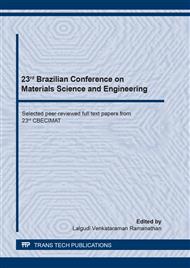p.239
p.244
p.250
p.256
p.262
p.268
p.272
p.278
p.284
Addition of Ornamental Rock Residues on Ceramic Blocks: Physical and Chemical Analysis
Abstract:
The incorporation of industrial waste in cementitious materials is an alternative for its adequate disposal. Among the residues that do not yet have adequate disposal are the residues created by the ornamental rock industries. In this context, this work aims to identify and characterize clays of the region where the ornamental rock industry is dominant and to verify the performance of the ceramic masses with the incorporation of the marble and granite residue. Physical and chemical characterization tests were performed on both clay and residues. After the identification of the two best clays, ceramic masses were prepared where it was possible to evaluate the performance of the clays with each of the residues in incorporations up to 20 wt.%. The results indicated that CI-A with 15 wt.% marble incorporation obtained the best performance.
Info:
Periodical:
Pages:
262-267
Citation:
Online since:
October 2020
Keywords:
Price:
Сopyright:
© 2020 Trans Tech Publications Ltd. All Rights Reserved
Share:
Citation:


